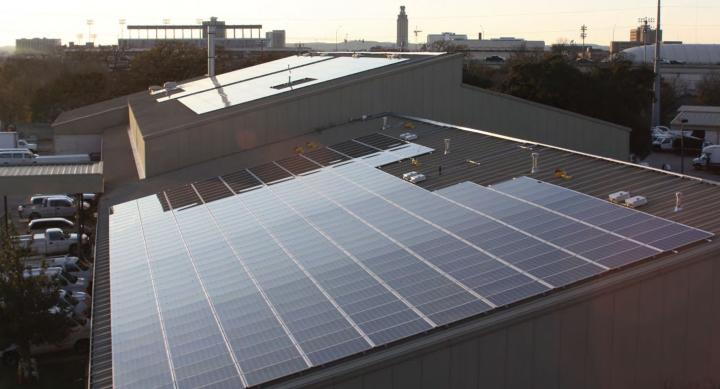
Solar array on the Facilities Complex roof. Photo: Griffin Gardner
Generation
UT Austin's power plant supplies almost 100% of the power and thermal requirements for over 20 million square feet serving 70,000 faculty, students and staff. Energy management efforts have enabled UT Austin to hold fuel consumption equivalent to 1977 levels while campus doubled in gross building space. The Hal Weaver Power Plant has won several international awards for efficiency and was recently recognized as the first in the world PEER: Campus.
Conservation
In 2011, the Natural Resource Conservation Plan set a goal of reducing demand side energy consumption at the building level by 20% per square foot by the year 2020 using 2009 as the base year. The plan was updated in 2014. The Energy Management and Optimization (EMO) team acheived this goal early - in January 2018. Since the EUI goal was reached two years early, a new goal was established based on the Demand-Side Strategic Plan (DSSP) for energy management. The DSSP provides a roadmap of energy goals and priorities for UT Austin over the next 15 years. The goal is to reduce campus-wide EUI by two percent annually, which will offset the projected campus energy growth.
Renewables
UT Austin has installed just over 500 kw of solar photovoltaic arrays on the main campus, almost all in support of research initiatives. A 2 million btu solar thermal array on the NHB building is the largest of several thermal arrays. In 2015, the university began buying Austin Energy GreenChoice power for 10% of the demand at the Pickle Research Campus.
UTWIN: UT Campus "Digital Twin" Energy Needs Project

The UTWIN project is an interactive map developed by researchers at the Intelligent Environments Lab to look at past, present, and future energy needs for the UT Austin campus. The goal was to combine information from different "silos" across campus to communicate energy needs to the public in order to make smart energy decisions in the face of climate change. Faculty and staff from the Jackson School of Geosciences, the Cockrell School of Engineering, and UT's Facilities Services contributed to the project.
